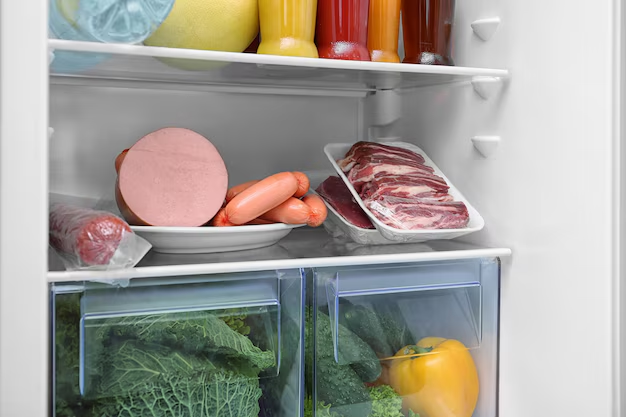Unlocking the Secrets to a Perfectly Organized Refrigerator
Are you tired of constantly rummaging through your refrigerator only to find expired products or ingredients you forgot you had? Maintaining an organized refrigerator is more than just a neatness issue; it plays a crucial role in preserving the freshness of your food and optimizing your cooking efficiency. With a well-organized fridge, you'll reduce food waste, save money, and make meal prep a breeze. Let's delve into some practical strategies to maximize your refrigerator's potential.
Why Organizing Your Refrigerator Matters
Before we jump into the how, let's discuss the why. An organized refrigerator:
- Preserves Food Freshness: Correct placement can extend your food's shelf life by providing the ideal temperature and moisture conditions.
- Reduces Waste: Knowing where everything is ensures you use ingredients before they spoil.
- Improves Efficiency: Streamlines meal prepping by keeping everything you need at hand.
- Saves Money: Less food waste means fewer trips to the grocery store, cutting down your grocery bill.
The Basics of Refrigerator Zones
Understanding Refrigerator Layout
Refrigerators generally consist of several zones, each designed for storing different types of food. Recognizing these zones can significantly enhance your food's shelf life.
Top Shelf
The top shelf tends to have the most consistent temperature throughout, making it perfect for ready-to-eat foods, leftovers, and drinks.
Middle shelves
Use the middle shelves for dairy products and items you often reach for, like condiments or yogurt. This area maintains a stable temperature to keep these items fresh.
Bottom Shelf
The bottom shelf is often the coldest part of the refrigerator, ideal for raw meat, poultry, or fish. Placing them here minimizes the risk of these items contaminating other foods.
Crisper Drawers
Designed for optimal humidity, use these drawers to store fruits and vegetables. Many refrigerators have dual drawers with customizable humidity settings—choose high humidity for leafy greens and low humidity for fruits.
Refrigerator Door
While convenient, the door tends to have the most fluctuating temperature. Store condiments, juices, and butter here, but avoid placing eggs and milk due to their sensitive nature.
Step-by-Step Guide to Organize Your Refrigerator
1. Empty and Clean Your Fridge
Begin with a clean slate:
- Remove everything: Take out all food items, shelves, and drawers.
- Wipe and sanitize: Use mild soapy water and a soft cloth to clean the interior. Ensure all surfaces are dry before replacing contents.
2. Categorize Food Items
Sort items into categories:
- Staples: Milk, eggs, cheese
- Leftovers and ready-to-eat meals
- Fruits and vegetables
- Meat and poultry
- Condiments and sauces
3. Arrange with Purpose
Utilize the zones for strategic placement:
- Top Shelf: Place leftovers and ready-to-eat foods for easy access.
- Middle Shelves: Keep dairy and items frequently used.
- Bottom Shelf: Designate space for raw meats to prevent cross-contamination.
- Crisper Drawers: Customize humidity for fruits and vegetables.
- Door Compartments: Fill with condiments and non-perishables.
4. Implement Storage Solutions
Consider additional tools:
- Clear Bins: Help categorize and create more space.
- Lazy Susans: Ideal for small items and condiments.
- Labels: Aid in quickly identifying items and their expiration dates.
Additional Tips for Maintaining Fridge Organization
Conduct Regular Checks
- Weekly Inventory: Spend a few moments each week to assess what food items are nearing expiration and need to be used.
- Revise Layout: As grocery habits change, adjust storage methods to match these shifts.
Speed Up Chilling
After a big grocery haul, consider boosting your fridge’s cooling power temporarily to ensure all new items are quickly brought to the proper temperature.
Invest in a Thermometer
Refrigerator thermometers help ensure the fridge stays at the optimal temperature. The USDA suggests keeping the refrigerator at or below 40°F (4°C) to minimize bacteria growth.
Summary: Key Takeaways for an Organized Refrigerator
To make the most out of your refrigerator, remember these core principles:
- 🗂️ Categorize Foods: Keep similar items together in designated zones.
- 📏 Maximize Shelf Space: Use organizational tools like bins and labels.
- 🤒 Monitor Temperatures: Optimum fridge temperature prevents spoilage.
- 🔄 Regular Clean-ups: Routine maintenance keeps hygiene in check.
By following these guidelines, your refrigerator will not only look tidy but become a functional asset in reducing waste and ensuring your meals are made efficiently. Whether you're a busy parent, culinary enthusiast, or just someone looking to reduce clutter, these steps will help you maintain an organized, efficient, and effective refrigerator space.
